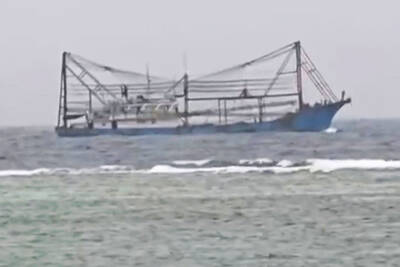The US on Sunday stood at the brink of a once-unthinkable tally: 500,000 people lost to COVID-19.
A year into the pandemic, the running total of lives lost was about 498,000 — roughly the population of Kansas City, Missouri, and just shy of the size of Atlanta.
The figure compiled by Johns Hopkins University surpasses the number of people who died in 2019 of chronic lower respiratory diseases, stroke, Alzheimer’s, flu and pneumonia combined.

Photo: Reuters
“It’s nothing like we have ever been through in the last 102 years, since the 1918 influenza pandemic,” US National Institute of Allergy and Infectious Diseases Director Anthony Fauci said on CNN’s State of the Union.
The US COVID-19 death toll reached 400,000 on Jan. 19 in the waning hours in office for then-US president Donald Trump, whose handling of the crisis was judged by public health experts to be a singular failure.
The US was expected to pass the next grim milestone yesterday. US President Joe Biden was to mark the US crossing 500,000 lives lost from COVID-19 with a moment of silence and a candle lighting ceremony at the White House.
Biden was to deliver remarks at sunset to honor the dead, the White House said.
He was expected to be joined by first lady, Jill Biden, and US Vice President Kamala Harris and her husband, Doug Emhoff.
The first known deaths from the virus in the US happened in early February last year, both of them in Santa Clara County, California. It took four months to reach the first 100,000 dead. The toll hit 200,000 deaths in September and 300,000 in December. Then it took just more than a month to go from 300,000 to 400,000 and about two months to climb from 400,000 to the brink of 500,000.
Joyce Willis of Las Vegas is among the countless Americans who lost family members during the pandemic. Her husband, Anthony Willis, died on Dec. 28 last year, followed by her mother-in-law early last month.
There were anxious calls from the intensive care unit when her husband was hospitalized. She was unable to see him before he died, because she, too, had the virus and could not visit.
“They are gone. Your loved one is gone, but you are still alive,” Willis said.
Despite efforts to administer COVID-19 vaccines, a widely cited model by the University of Washington projects the US death toll would surpass 589,000 by June 1.
“People will be talking about this decades and decades and decades from now,” Fauci said on NBC’s Meet The Press.

A Chinese aircraft carrier group entered Japan’s economic waters over the weekend, before exiting to conduct drills involving fighter jets, the Japanese Ministry of Defense said yesterday. The Liaoning aircraft carrier, two missile destroyers and one fast combat supply ship sailed about 300km southwest of Japan’s easternmost island of Minamitori on Saturday, a ministry statement said. It was the first time a Chinese aircraft carrier had entered that part of Japan’s exclusive economic zone (EEZ), a ministry spokesman said. “We think the Chinese military is trying to improve its operational capability and ability to conduct operations in distant areas,” the spokesman said. China’s growing

Nine retired generals from Taiwan, Japan and the US have been invited to participate in a tabletop exercise hosted by the Taipei School of Economics and Political Science Foundation tomorrow and Wednesday that simulates a potential Chinese invasion of Taiwan in 2030, the foundation said yesterday. The five retired Taiwanese generals would include retired admiral Lee Hsi-min (李喜明), joined by retired US Navy admiral Michael Mullen and former chief of staff of the Japan Self-Defense Forces general Shigeru Iwasaki, it said. The simulation aims to offer strategic insights into regional security and peace in the Taiwan Strait, it added. Foundation chair Huang Huang-hsiung

PUBLIC WARNING: The two students had been tricked into going to Hong Kong for a ‘high-paying’ job, which sent them to a scam center in Cambodia Police warned the public not to trust job advertisements touting high pay abroad following the return of two college students over the weekend who had been trafficked and forced to work at a cyberscam center in Cambodia. The two victims, surnamed Lee (李), 18, and Lin (林), 19, were interviewed by police after landing in Taiwan on Saturday. Taichung’s Chingshui Police Precinct said in a statement yesterday that the two students are good friends, and Lin had suspended her studies after seeing the ad promising good pay to work in Hong Kong. Lee’s grandfather on Thursday reported to police that Lee had sent

A Chinese ship ran aground in stormy weather in shallow waters off a Philippines-controlled island in the disputed South China Sea, prompting Filipino forces to go on alert, Philippine military officials said yesterday. When Philippine forces assessed that the Chinese fishing vessel appeared to have run aground in the shallows east of Thitu Island (Jhongye Island, 中業島) on Saturday due to bad weather, Philippine military and coast guard personnel deployed to provide help, but later saw that the ship had been extricated, Philippine navy regional spokesperson Ellaine Rose Collado said. No other details were immediately available, including if there were injuries among